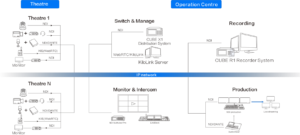Compared to H.264, the file size of the video encoded by H.265 will be reduced by approximately 39-44%. When the bit rate is reduced by 51-74%, the quality of H.265 encoded video can be similar to or better than H.264 encoded video. H.265 is therefore regarded as the next-generation mainstream standard for video codec.

H.265 encoder technology
In the game between the demand for ultra-high-definition video quality and the shackles of network broadband, video coding is undoubtedly the focus of all users’ attention. With H.264 – the current mainstream compression technology, the bit stream of 1 channel 4K@25fps image transmission is expected to be 10-15Mbps. H.265 retains some of the original technologies on the basis of H.264, and at the same time it makes improvements to increase the compression rate and coding quality, and double the compression efficiency of video surveillance images.
Under the same image quality, compared to H.264, the size of the video encoded by H.265 will be reduced by approximately 39-44%. When the bit rate is reduced by 51-74%, the quality of H.265 encoded video can be similar to or better than H.264 encoded video. H.265 is therefore regarded as the next-generation mainstream video codec standard.
At the moment when the market share of 4K/8K cameras is far lower than that of 1080P or 3MP cameras, H.265 will first be applied in the field of HD and HD+ video, leaving more space for H.265 for standard optimization, H. 265 encoder is optimized to further reduce computational complexity, improve compression efficiency, and prepare for the large-scale popularization of 4K/8K.
However, H.265 adopts smarter algorithms to process images. While maintaining quality and keeping a lower bit rate, it also has to pay a certain price: it significantly increases the compression effect, and the complexity of the algorithm it relies on needs to be several times that of the current 2K. The computing power of the H.264 codec used for resolution deployment is supported, and a large number of servers are required to provide this capability. However, a large part of the traditional video surveillance picture is static, which also means that a lot of information in the picture is invalid, and this invalid information will still occupy computing power and bandwidth resources.
Therefore, on the basis of H.265, Kiloview aims for smarter coding for video: automatically separates the moving part of the picture from the static part, and focuses on analyzing the moving picture, thereby reducing the bit rate and comparing H.265 further reduces the stream and storage costs.
Which Kiloview video encoders support h.265?
Kiloview’s S series H.265 encoder is an ultra-high-definition (UHD) video encoding device, which supports up to 4KP60 video input, supports H.265 (HEVC) / H.264 high-performance encoding, and supports wired/WiFi wireless network transmission. And also it supports SRT/RTMP/ RTMPS/HLS/UDP/RTSP/Onvif/ and more protocols.
It can be widely used in 4K video program production, 4K ultra-high-definition video live broadcast, 4K+5G application solutions, 4K video Internet point-to-point transmission, 4K large-screen display projects, 4K video networked recording and storage, HDMI input use, 4K wireless transmission Scene etc.
S1 supports 3G-SDI/4Kp30 HDMI dual interface (choose one encoding from two);
S2 supports 4Kp30HDMI video input;
S2 Pro supports 4Kp60 HDMI input.










